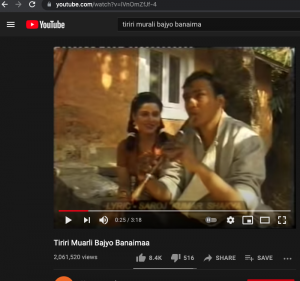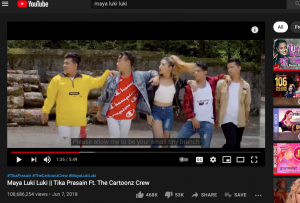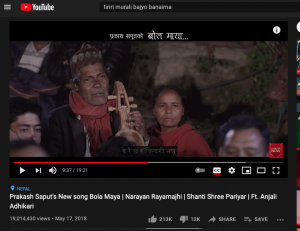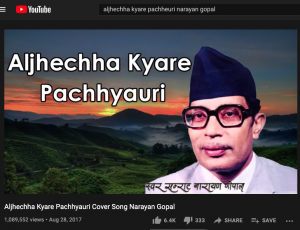Nepali
Additional Listening Resources
SONGS
Listening to Nepali songs not only provides good background listening but also rich vocabulary and opportunities for cultural understanding. Please see this previous lesson on listening to Nepali songs for strategies on how to understand lyrics and engage with new vocabulary. It is incredibly important to be able to unpack lyrics and music videos with a native speaker in order to gain the most accurate understanding of figures of speech/Nepali culture! This list of songs is broken down into folk/classic and then more modern songs.
लोक/ कालजयी गितहरु (Folk/Classic Songs)
This song is about one’s चेली , or one’s daughter who has gotten married and left the home. It is an old song that documents the struggles the family faces in missing their daughter who never returns home after getting married.

This is another beautiful older song that talks about the beauty of the forest, and how one cherishes the memories. There is a different kind of flute in this song as well called the मुरली, which is more similar to a fife (I believe).
आधुनिक गीतहरु (Modern Songs)

This is a fun pop song that has very poetic lyrics about pining after someone who does not love them back. लुक्नु means to hide, so this song is about love hiding. There are closed captions for this song, so you can (with a grain of salt) check the translation as you work through the lyrics.

Be warned, Bola Maya is a very sad song. A woman’s husband dies while working abroad (which is unfortunately not very uncommon in Nepal) and it takes you through her grieving and reflecting back on their relationship, which unveils many aspects of Nepali culture. It also shows you a traditional Nepali “sarangi” (seen in the screenshot above) and the difficulties that face many Nepali families and communities. The woman’s husband always wanted to be a “hero” (or actor/singer), so some of the vignettes shown document his aspirations and the deep sadness that accompanies his death.
INSTRUCTIONAL VIDEOS
I sometimes like to listen to these Nepali language videos while at the gym, as they are pretty basic. This is the link to Barsha’s YouTube channel where you have a wide range of instructional videos on the alphabet to commonly used greetings or sayings in Nepali. To more actively engage with these videos, I would suggest writing down some of the sayings and then trying to incorporate them into conversation with a language mentor or native speaker. Putting it into practice and application is key!
NEPALI CARTOONS AND NURSERY RHYMES
Children’s cartoons are a great way to practice listening and comprehension at all levels. There are a number of Nepali fairy-tales and folk-tales that learners can search for on YouTube which also provide English subtitles. For best learning outcomes, learners should first watch and listen to the stories and attempt to transcribe, translate, and mark vocabulary they do not understand. Next, re-watch the video with subtitles on and compare your transcription. Below are a few examples that learners can use to try this exercise:
बाघ आयो बाघ आयो Bagh Aayo, Bagh Aayo
Have you heard of The Little Boy Who Cried Wolf? Welcome to the Nepali version of that fairy-tale. This story is for beginner and intermediate Nepali learners and uses animal, environment, and village vocabulary to tell the story.
भ्यागुतो राजकुमार -Bhyaguto Rajkumar
Another familiar fairy-tale for many is The Frog Prince. This video uses a plethora of animal and political vocabulary delivered in a palatable way. Many grammatical structures and tenses are used speaking in from first to third person.
लोक प्रिय नेपाली बाल गीत-Nepali Rhymes Collection
TRANSCRIBING
Whether you are transcribing a radio show, podcast, or interview, listening over and over again to Nepali audio can be incredibly helpful! Even recording a session with your language mentor could be helpful to transcribe afterwards to work on listening, scribing, and then fully translating what you hear and write down. Transcribing can target not only listening skills but Nepali Devanagari writing skills as well! Here are some helpful hints while transcribing interviews, which could be applied to transcribing other forms of audio as well.
- Use Easy Nepali Typing for transcribing. But, be sure to read over your typing every minute of written transcription or so to make sure there are no typos! It is also helpful to look up correct spelling if you are unsure using Google Translate.
- Be aware of “emphatic particles” (see Sam’s extremely helpful lesson on these if you are unsure what this means!) I would suggest checking these over with a native speaker for both correct spelling and meaning.
- If you hear a certain word or grammar form being used that you are unfamiliar with, check it over with your language mentor and use it as a point for practice. Using the highlight function on a Word document is helpful for this as you are transcribing to keep track of points that you want to return to. Create a Quizlet or Anki card deck to practice these words. Again, it is helpful to verify with your mentor about new words, but then you can practice them independently!
- You can also use the highlight function to keep track of mistakes you made in the audio or that you hear in the audio (if you are listening to a radio program or podcast). This can be helpful practice in keeping track of what you may need more practice with.







